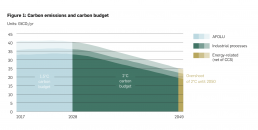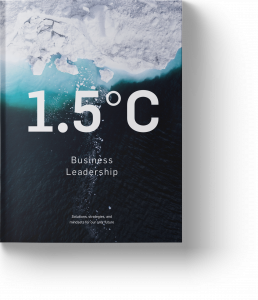With Remi Eriksen, President & CEO, DNV GL
Existing technology can deliver the future we desire, including meeting the Paris Agreement targets, but only through considerable acceleration on many fronts. That is the message from Remi Eriksen, President and CEO of DNV GL.
That the world is very far away from limiting global warming to 1.5°C by the end of this century is widely known. “Less commonly understood is exactly how far we are from delivering that future and what needs to be done to close the gap between the current warming trajectory and 1.5°C”, says Remi Eriksen, President and CEO of DNV GL. “That is one of the main reasons why I initiated a research effort to study the energy transition and provide answers to these questions. The findings worry me greatly, as, indeed they should all of us”.
Recently released in its third edition, the findings in DNV GL’s annual Energy Transition Outlook – a Global and Regional Forecast to 2050 are alarming, precisely because they are not alarmist. Sverre Alvik, Director of DNV GL’s Energy Transition research programme, explains how DNV GL has spent the better part of four years designing, expanding, and refining a model of the world’s energy system, encompassing demand and supply of energy globally. “We have drawn on the real-world expertise of hundreds of colleagues and dozens of experts around the world in governments and academia.”
A fast transition
Sverre characterises DNV GL’s forecast as a ‘central case’ for the energy transition. “There is no wishful thinking in our forecast”, he explains. “Policy-wise we expect a heightened focus on decarbonisation, but we conservatively model carbon prices towards 2050 at levels not very much higher than today”. Even so, DNV GL predicts a rapid transition to a lower-carbon energy system, with fossil and non-fossil sources split almost evenly in the energy mix by mid-century (as opposed to the present 80% fossil/ 20% non-fossil ratio). Electrification will more than double from today’s levels by 2050, with 63% of that electricity supplied by solar PV and wind. Efficiency gains in how energy is both supplied and used will also intensify over the coming decades, such that the world’s primary energy use will in fact peak in 2030, despite a growing global economy and population.
But emissions keep coming
Even with these dramatic changes, cumulative emissions associated with DNV GL’s forecast indicate a 2.4°C warming of the planet by the end of this century, relative to the preindustrial average — a level considered dangerous by the Intergovernmental Panel on Climate Change and the world’s scientific community.
With reference to Figure 1, Sverre explains: “We see in our forecast that the 1.5°C carbon budget is exhausted in 2028; and humanity exceeds the 2°C budget in 2049, and from that point continues burning fossil fuels until almost the end of the century. In the year 2050 alone, the world’s energy system will still emit 18 gigatonnes of CO2 (GtCO2). The result is surplus emissions above the 1.5°C budget of a staggering 770 GtCO2 by 2050. The energy future we forecast is thus unequivocally not fast enough”.

What can be done?
Sverre and his forecasting team have quantified three main energy-related responses.
“We could, from this day forward, generate all our electricity from renewable sources. Sadly, if this was all we did, we would still fall short of even the 2-degree goal, let alone 1.5°C.
We could start using less energy, reducing energy intensity at a much higher speed than the annual 2.5% we forecast. But annual reductions would need to be 4.8%/yr to achieve 2°C, and we consider this unrealistic. Efficiency gains as the only means to achieve a 1.5°C future are simply unattainable.
We could capture carbon in enormous quantities. But even if all emissions associated with coal- and gas-fired power were to be captured, that alone would not be enough. And, given the snail-paced development of Carbon Capture and Storage (CCS) worldwide in recent years, it appears to be a particularly slender straw to clutch at.”
No silver bullet
If the world is to avoid dangerous warming, policies must be developed to tackle at least three fronts simultaneously: more energy efficiency; more renewables; and industrial-scale CCS. Sverre cautions, “this should not be read as ‘a little bit
of everything’; per contra, we require a lot of everything, and making sure such efforts together at scale is hugely difficult”. For example, large improvements in two of the areas that DNV GL identifies might be enough to deliver a 2°C future, but would not stretch to the target of 1.5°C.
We have the technology, but not the policy
“The technologies to deliver the 1.5°C target exist: if they are deployed rapidly, their costs will fall quickly, setting up a self-reinforcing effect”, says Sverre. However, this can only succeed if policies enabling the Nationally Determined Contributions (NDCs) under the Paris Agreement — are dramatically strengthened. Figure 2 shows how a combination of measures can lead us to 1.5°C or 2°C. As illustrated, getting emissions down is not only important, but also very urgent.

Take action now
To Sverre’s mind, too many policy-makers are setting too much store by net-negative emissions technology — permanently removing CO2 from the atmosphere by means of, for example, reforestation and afforestation, bioenergy with carbon capture and storage (BECCS) and direct air capture.
“None of these technologies exist at scale today. Yet, so many 1.5°C and 2°C scenarios ‘achieve’ their target by imagining that large-scale net-negative emissions programmes will be initiated towards the middle and end of this century.”
As a world-leading risk management company, DNV GL views the risk and the consequences of a delayed response by humanity as too high. Allowing anthropogenic emissions to persist risks triggering any number of tipping points, such as the premature melting of permafrost releasing large amounts of methane.
“Our preferred focus is on what can be done today”, says Sverre. “Existing technology can deliver the future we desire — including meeting the Paris Agreement target — but only through accelerated scaling on many fronts.”



